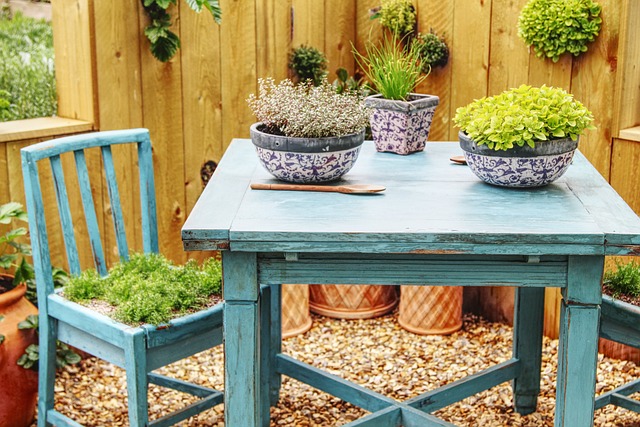Yard waste composting is an eco-friendly approach to garden maintenance that transforms organic materials like leaves, grass clippings, and kitchen scraps into nutrient-rich soil amendments. This process not only supports plant growth and enriches the garden ecosystem but also diverts waste from landfills, thereby reducing methane emissions and mitigating climate change by lessening greenhouse gas emissions associated with organic matter decomposition. Garden enthusiasts can engage in sustainable yard waste removal and recycling by setting up a dedicated compost area, maintaining proper moisture and aeration, and balancing 'green' and 'brown' materials for optimal decomposition. Composting effectively contributes to a closed-loop system that recycles nutrients within the garden, reduces reliance on chemical fertilizers, and promotes biodiversity, all of which align with broader sustainability goals. By adhering to diligent composting practices—such as selecting appropriate materials, monitoring the carbon-to-nitrogen ratio, and regularly turning the compost—individuals can contribute to a healthier environment through responsible yard waste removal and recycling. This results in high-quality compost that enhances soil structure, water retention, and microbial diversity, leading to more robust plant growth and a more sustainable gardening approach.
Gardening enthusiasts looking to enrich their plots and contribute to environmental sustainability can harness the power of compost. This article delves into creating a compost system for yard waste, offering insights on the benefits of composting for both your garden’s vitality and the broader ecosystem. From selecting an appropriate compost bin or pile to understanding the intricacies of the composting process, we guide you through each step. Learn how efficient yard waste removal and recycling can transform kitchen scraps and lawn trimmings into valuable soil amendments that promote healthy plant growth. Join us as we explore the art of composting for a greener garden and planet.
- Understanding Yard Waste Composting: Benefits for Your Garden and the Environment
- Preparing Your Space: Designating a Compost Area for Efficient Yard Waste Removal
- Selecting the Right Compost Bin or Pile for Optimal Yard Waste Recycling
- Types of Yard Waste Materials Suitable for Composting
- The Composting Process: Step-by-Step Guide for Garden Enthusiasts
- Maintaining and Monitoring Your Compost: Tips for a Balanced and Healthy Soil Ecosystem
Understanding Yard Waste Composting: Benefits for Your Garden and the Environment

Yard waste composting is a sustainable practice that transforms organic materials from your garden into nutrient-rich soil, which can then enhance plant growth and garden health. By participating in yard waste removal and recycling, garden enthusiasts can significantly reduce the amount of organic debris sent to landfills, thereby lessening methane emissions that result from decomposing matter in anaerobic conditions. This process not only benefits your garden by providing a source of organic matter to improve soil structure and fertility but also contributes to environmental conservation. Composting yard waste like leaves, grass clippings, and kitchen scraps encourages a closed-loop system, where nutrients are recycled within the ecosystem of your garden, reducing the need for chemical fertilizers. This approach supports biodiversity and promotes a more sustainable and self-sufficient gardening practice. Additionally, by engaging in yard waste removal and composting, you’re contributing to the reduction of greenhouse gas emissions, as decomposing organic matter in landfills is a significant source of these gases. Embracing this eco-friendly habit not only enriches your soil but also plays a part in combating climate change.
Preparing Your Space: Designating a Compost Area for Efficient Yard Waste Removal

Garden enthusiasts who aim to sustain their greenery with organic matter can significantly benefit from compost creation. Preparing your space for efficient yard waste removal is a critical first step in this eco-friendly practice. To initiate, select a suitable location within your yard that is flat and easily accessible for adding materials and retrieving matured compost. This area should be somewhat secluded to minimize odors and attractants, yet convenient enough for frequent visits. Ensure the chosen spot is near a water source, as moisture is key in maintaining the balance of your compost pile. The designated area can be marked out with borders made from wood, stones, or even repurposed fence panels to contain the materials and keep the composting process contained and orderly. This not only streamlines yard waste removal but also prevents the spread of weeds and seeds that may compost into the garden or surrounding areas.
Once your space is designated, consider the size of your compost pile in relation to your yard’s waste output. A larger compost bin might be necessary if you generate substantial yard waste, such as leaves, grass clippings, and pruned branches. Smaller setups are sufficient for households with limited organic waste. Properly sized compost bins or piles facilitate the decomposition process by allowing for effective aeration and moisture retention, which are crucial for recycling yard waste efficiently. Regular monitoring and turning of the compost will accelerate the breakdown of materials, leading to rich, nutrient-dense compost that can be utilized to enhance soil health and promote lush garden growth.
Selecting the Right Compost Bin or Pile for Optimal Yard Waste Recycling

For garden enthusiasts looking to recycle yard waste effectively, selecting the right compost bin or pile is a critical first step in the composting process. The ideal composting setup not only facilitates the breakdown of organic materials but also harmonizes with the surrounding environment and your specific needs. When choosing between a compost bin or an open pile, consider the volume of yard waste you generate and the space available in your garden. Compost bins, often made from wood, plastic, or metal, offer structural integrity and can help manage composting materials by keeping them contained and aerated for optimal decomposition. They also tend to be animal-proof, preventing unwanted scavengers from accessing your compost. On the other hand, an open pile allows for greater flexibility in size and material inclusion, and can be a more organic addition to your garden’s landscape. However, it may require more vigilance against pests and weather elements. Regardless of the option you choose, proper yard waste removal and recycling hinge on maintaining aeration, moisture control, and regular turning or mixing of the compost material to ensure microbial activity is at its peak. This will not only expedite the decomposition process but also yield a rich, nutrient-dense compost that will greatly benefit your garden’s health and vitality.
Types of Yard Waste Materials Suitable for Composting

Garden enthusiasts can significantly contribute to sustainable waste management practices by engaging in yard waste removal and recycling through composting. Composting transforms organic materials from yard maintenance, such as grass clippings, leaves, and garden waste, into nutrient-rich humus that enriches the soil. This process not only reduces the volume of waste sent to landfills but also creates a valuable product for gardening.
Effective composting begins with selecting the right types of yard waste materials. Ideal compost ingredients include green waste like kitchen scraps, coffee grounds, and fresh grass clippings, which provide nitrogen and moisture. Brown materials such as dried leaves, straw, and shredded paper contribute carbon essential for the decomposition process. Woody branches and twigs can be included, preferably chopped into smaller pieces to expedite the breakdown. It’s also beneficial to include eggshells, which are high in calcium carbonaate, and are excellent for balancing soil pH. By understanding what materials work best in your compost pile or bin, you can optimize the composting process and contribute to a healthier garden and environment through yard waste removal and recycling.
The Composting Process: Step-by-Step Guide for Garden Enthusiasts

Gardening enthusiasts who are looking to enrich their soil naturally can turn to composting as an eco-friendly and productive activity. Composting is a natural process that recycles yard waste and other organic materials into a nutrient-rich soil amendment. By following a step-by-step guide, you can efficiently convert kitchen scraps and yard waste into valuable compost for your garden.
Begin by selecting an appropriate composting system that suits the size of your garden and the amount of waste you generate. There are various types of compost bins available, from simple piles to enclosed tumbling bins, or even hidden compost containers that can be integrated into your garden’s aesthetics. Once your composting area is established, start by adding a balanced mix of ‘browns’ (carbon-rich materials like dried leaves, straw, or shredded paper) and ‘greens’ (nitrogen-rich materials such as kitchen scraps, grass clippings, and coffee grounds). Maintain a carbon to nitrogen ratio of approximately 30:1. Regularly turn the compost pile or use a tumbling bin to ensure aeration and moisture is evenly distributed. This will help speed up the decomposition process and prevent odors. Monitor the moisture level; it should be as wet as a wrung-out sponge. Throughout the composting process, continue to add both browns and greens, avoiding meat, dairy, and oily substances that can attract pests or produce unwanted odors. Yard waste removal and recycling are thus transformed into a resourceful practice, contributing to the health of your garden and reducing landfill waste. Monitor the temperature and texture of your compost; these indicators will tell you when it’s ready to use. Finished compost should be crumbly, dark, and earthy in scent. Apply this nutrient-dense material to your garden beds to improve soil structure, increase water retention, and foster beneficial microbial life, leading to healthier plants and a more sustainable gardening practice.
Maintaining and Monitoring Your Compost: Tips for a Balanced and Healthy Soil Ecosystem

Garden enthusiasts can enhance their yard waste removal and recycling efforts by effectively maintaining and monitoring their compost for a balanced and healthy soil ecosystem. The key to successful composting lies in understanding the balance between green and brown materials, which are essential for creating nutrient-rich humus. Green materials, such as kitchen scraps and fresh grass clippings, introduce nitrogen, while brown materials like dried leaves and shredded paper contribute carbon. A balanced compost pile should have a homogeneous appearance with a temperature that gradually increases and then cools down before being turned again. Regularly monitoring the moisture level is crucial; it should be as moist as a wrung-out sponge, allowing for optimal decomposition without becoming waterlogged.
Airflow within the compost heap cannot be overstated; ensure there are ample spaces where oxygen can circulate to support aerobic microbial activity. Frequent turning of the compost not only aids in this process but also in redistributing moisture and ensuring an even decomposition process. Additionally, maintaining a proper carbon-to-nitrogen ratio is vital for preventing odors and attracting pests. Yard waste removal and recycling practices should be integrated with composting by using organic materials that would otherwise be disposed of. This not only reduces landfill waste but also contributes to the creation of valuable compost. By diligently managing these aspects, garden enthusiasts can cultivate a thriving soil ecosystem that will return nutrients and improve soil structure for their gardens, creating a sustainable and rewarding composting practice.
Gardening enthusiasts looking to enhance their gardens sustainably can reap both immediate and long-term benefits by engaging in yard waste composting. This eco-friendly practice not only enriches the soil but also contributes to environmental conservation. By designating a dedicated compost area, selecting an appropriate bin or pile, and adhering to the outlined process, gardeners can efficiently recycle organic matter into nutrient-rich compost, effectively transforming yard waste removal into a resource rather than waste. The guide provided ensures that your compost will thrive, leading to a healthier garden ecosystem. Embracing compost creation is a simple yet impactful step towards sustainability and gardening excellence.
